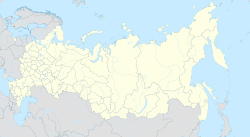Bitschura
Village
|
||||||||||||||||||||||||||||
|
||||||||||||||||||||||||||||
|
||||||||||||||||||||||||||||
Bitschura ( Russian Бичура ; Buryat Бэшүүрэ ) is a village (selo) in the Republic of Buryatia ( Russia ) with 9145 inhabitants (as of October 14, 2010).
geography
The place is located in the wide valley through which the Chilok flows between the low mountain ranges Malchanski chrebet in the south and Saganski chrebet in the north, the so-called Bitschura or Chilok- Tschikoi depression. It extends for about 8 km along the left Chilok tributary Bitschura (also called Bitschurka), a little above the mouth. Bitschura is about 140 kilometers as the crow flies in a southerly direction from the republic capital Ulan-Ude .
Bitschura is the administrative center of Bitschursky Rajons and the rural municipality Bitschurskoje selskoje posselenije. In addition to the village, the rural community also includes the settlement of Sacharny Zavod (“sugar factory”) with a good 800 inhabitants on the left bank of the Chilok.
history
The place was first mentioned in 1723 as a "large village" after the first Cossack posts had been established in the area in 1689 . The name was probably derived from the Buryat / Mongolian name for a flat, bush-covered locality.
In 1768 the first group of 72 members of the ancient Orthodox religious community of the Semeiskije came to the place, who had been resettled to Siberia from the western parts of the Russian Empire along the border with the Kingdom of Poland on the instructions of Empress Catherine II . The Semeiskije shaped the development of the village.
In 1935 the village became the administrative seat of a newly created Rajon.
Population development
| year | Residents |
|---|---|
| 1939 | 7,371 |
| 1959 | 8,457 |
| 1970 | 10.130 |
| 1979 | 10,277 |
| 1989 | 11,156 |
| 2002 | 9,737 |
| 2010 | 9,147 |
Note: census data
Culture and sights
Bitschura is still the center of the old Orthodox culture today. There are several folklore ensembles , the folklore festival Bitschurskije jantari ( jantar , Russian for amber , after the amber chains , which are characteristic of the costume of the Semeisky women) takes place annually in Bitschura or one of the surrounding villages . Typical residential and farm buildings and facilities have also been preserved. There has been an old Orthodox church again since the 1990s.
The Rajon's Historical and Local Museum has existed in the village since 1965 .
Personalities
- Jelena Chorinskaja (actually Kotwitskaja; 1909-2010), writer and poet, born in Bitschura
Economy and Infrastructure
Bitschura is the center of an agricultural area with various companies in the food industry.
The village is located on the regional road R441 , which connects Muchorschibir, about 80 km away on the M55 "Baikal" road, with the city of Kjachta on the border with Mongolia and opens up the south-eastern part of the republic.
Individual evidence
- ↑ a b c Itogi Vserossijskoj perepisi naselenija 2010 goda. Tom 1. Čislennostʹ i razmeščenie naselenija (Results of the All-Russian Census 2010. Volume 1. Number and distribution of the population). Tables 5 , pp. 12-209; 11 , pp. 312–979 (download from the website of the Federal Service for State Statistics of the Russian Federation)
- ↑ a b Vladislav Ketkovič: Semejskie - starovery Zabajkalʹja . In: Geografija 23 (702) / 2003 (Russian)
Web links
- Official website of the Raion Administration (Russian)
- Unofficial local website (Russian)

